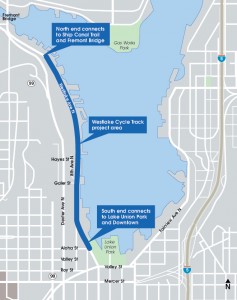Ed. Note: Peter has been following this issue closely, and in this piece for the Puget Sound Business Journal, he takes it a step further and offers up some creative thinking to lessen the impact of the “track” on the working waterfront. It’s good to see the PSBJ make his voice to the general public. Hopefully Seattle officials will work toward a solution for all stakeholders, and not just bicyclists.
City’s Plan for Westlake Bicycle Track Bad for Business and Seattle’s Liveability
The City is moving forward with a 10-foot wide, 1.2 mile dedicated bicycle track, between the Fremont Bridge and South Lake Union Park along Westlake Avenue North. Sounds great, doesn’t it? After all, what’s not to love about a bike path? So what’s the problem?
The impacted section of Westlake is the heart and soul of a diverse and vibrant economic cluster – a very rich century-old maritime community and a working, thriving waterfront. It’s also a recreational gem in an increasingly dense city. The unique mix of homeowners, businesses (some 300 of them), boaters and tourists generates millions of dollars in state, county and city taxes and is one of the few deep freshwater ports in the United States. The Westlake Avenue North community is also a year-round gateway for tourism, seeing more than 200,000 recreational visitors annually and home of the largest float plane port in the U.S. serving approximately 55,000 passengers per year. It relies heavily on vehicle access.
This area is blessed and cursed by its uniqueness. Unlike other neighborhoods or downtown Seattle, cars (i.e. customers, employees, residents and visitors to the neighborhood), service vehicles and fuel trucks have no places to park outside of the current 1.2 mile stretch. There are a fixed number of stalls that provides the lynchpin for this community.
Absent in the Seattle Department of Transportation’s process for this bike path has been an understanding of the negative economic impact if these water-related businesses are lost. Not to mention the impact on a recreational jewel.They state that one of their goals with this project is to “create a space that preserves parking, attracts customers and supports adjacent land and water uses.” But the current plan flies in the face of that assertion. It shows cutting into the parking area by 20 percent. This same community has seen parking reduced by 30 percent in recent years.
In a recent economic impact study commissioned by my marine trade association, 70 to 80 percent of businesses, residents and marina tenants surveyed said they frequently experience parking shortages in the corridor and 57 percent of respondents indicated that they had lost sales due to the already difficult parking situation. One business owner said that several customers recently told him they drove around for 20 minutes on Westlake looking for parking and failing to find it. As a result, they chose to go home. Take more parking away from the neighborhood and we are at risk of losing these marine businesses—perhaps to Edmonds, Everett or other cities that will reap the benefits. The aforementioned study also found that businesses along the corridor accounted for 2,165 full- and part-time jobs and an estimated annual revenue of $291 million.
As a biker, I welcome transportation choices. As a Seattle resident, urge the city to retain this important maritime and recreational resource.We can improve safety along this route, preserve more parking than what was proposed by the city and install a world-class bike lane.
Specifically, there are two small changes that will unleash dramatic improvements for the neighborhood:
1) Create a maritime zone along the 1.2 mile length, allowing water-dependent residents, boaters and marine businesses an ability to purchase parking access, similar to the City’s current Residential Parking Zones.
2) Reduce the sidewalk by one foot from eight feet (the current plan) to seven. This would result in saving 100 percent of the parking this section.
The good news is that Mayor Murray has proven that you can bring together diverse viewpoints in the name of good public policy. My group and this neighborhood ask SDOT to make these modifications to ensure we protect this area, which in turn will allow the tax dollars to continue to flow.
Seattle’s maritime community and abundant access to water for recreation and business alike is one of the many things that makes our metropolitan area such a desirable place to live, work and play.Protecting this community requires thoughtful planning, prioritization and commitment. SDOT to their credit has listened but that is all they have done to date. Now is the time to show us a revised plan that incorporates this input.
Peter Schrappen is vice president and director of government affairs at the Northwest Marine Trade Association and a member of the Westlake Cycle Track Design Advisory Committee


